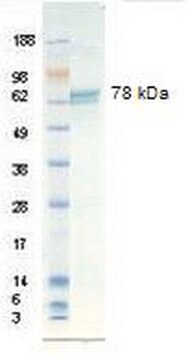676380
Valproic Acid sodium salt
≥98% (HPLC), solid, HDAC1 inhibitor, Calbiochem®
Synonym(s):
Valproic Acid, Sodium Salt, 2-Propylpentanoic Acid, Na
About This Item
Recommended Products
product name
Valproic Acid, Sodium Salt, A cell-permeable, short-chained fatty acid that inhibits histone deacetylase (IC₅₀ = 400 µM for HDAC1).
Quality Level
Assay
≥98% (HPLC)
form
solid
potency
400 μM IC50
manufacturer/tradename
Calbiochem®
storage condition
OK to freeze
desiccated (hygroscopic)
color
white
solubility
water: 50 mg/mL
shipped in
ambient
storage temp.
2-8°C
InChI
1S/C8H16O2.Na/c1-3-5-7(6-4-2)8(9)10;/h7H,3-6H2,1-2H3,(H,9,10);/q;+1/p-1
InChI key
AEQFSUDEHCCHBT-UHFFFAOYSA-M
General description
Biochem/physiol Actions
HDAC1
Packaging
Warning
Other Notes
Knupfer, M.M., et al. 2001. Anticancer Res.21, 347.
Phiel, C.J., et al. 2001. J. Biol. Chem.276, 36734.
Vaden, D.L., et al. 2001. J. Biol. Chem.276, 15466.
Yuan, P.X., et al. 2001. J. Biol. Chem.276, 31674.
Chen, G., et al. 1999. J. Neurochem.72, 1327.
Legal Information
Signal Word
Warning
Hazard Statements
Precautionary Statements
Hazard Classifications
Acute Tox. 4 Oral - Repr. 2
Storage Class Code
11 - Combustible Solids
WGK
WGK 3
Flash Point(F)
Not applicable
Flash Point(C)
Not applicable
Certificates of Analysis (COA)
Search for Certificates of Analysis (COA) by entering the products Lot/Batch Number. Lot and Batch Numbers can be found on a product’s label following the words ‘Lot’ or ‘Batch’.
Already Own This Product?
Find documentation for the products that you have recently purchased in the Document Library.
Customers Also Viewed
Our team of scientists has experience in all areas of research including Life Science, Material Science, Chemical Synthesis, Chromatography, Analytical and many others.
Contact Technical Service



















